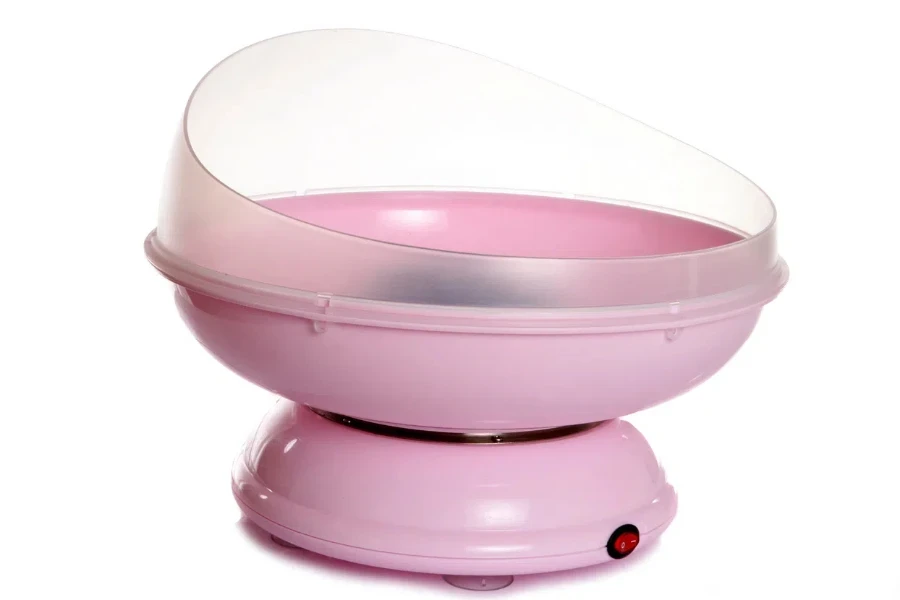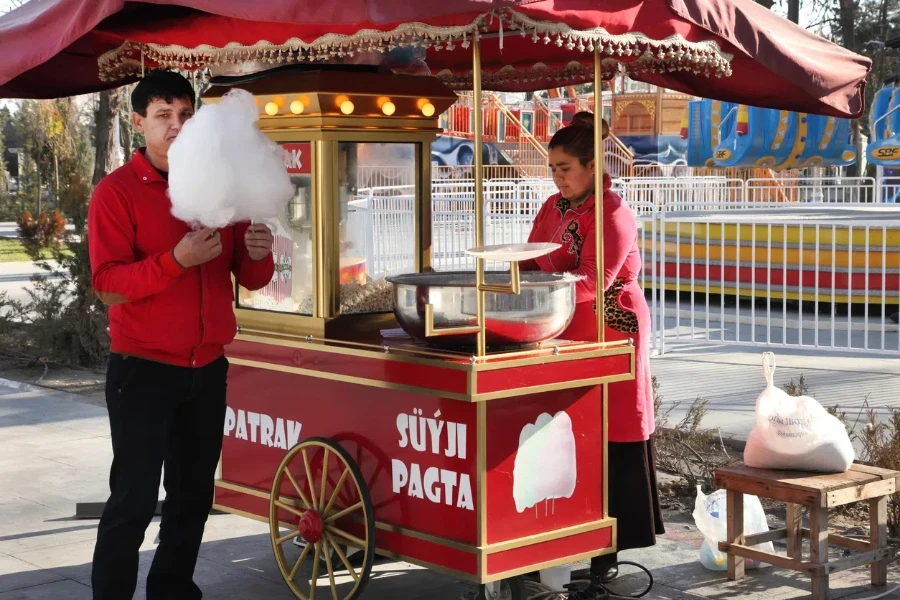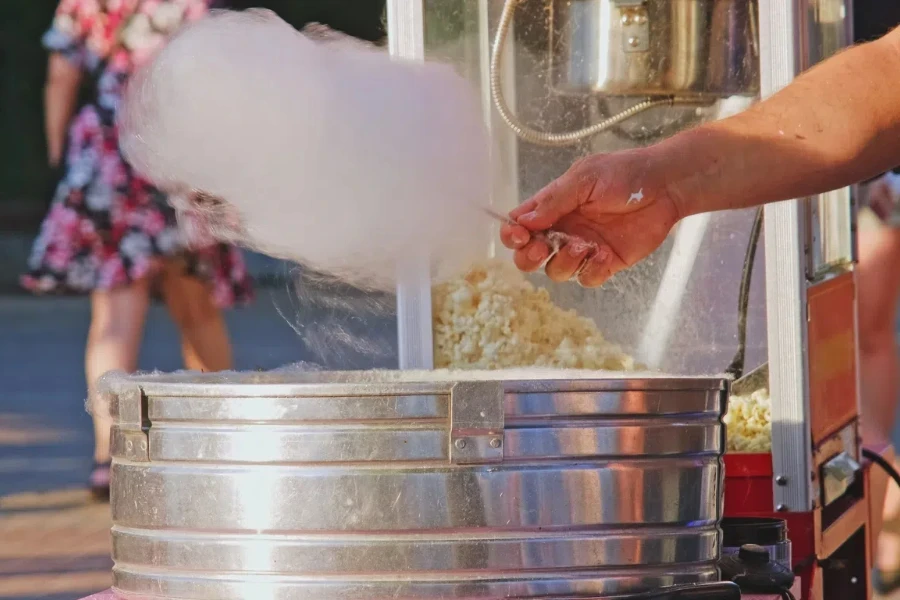In 2025, the demand for commercial cotton candy makers is set to soar, driven by the growing popularity of cotton candy at events and advancements in machine technology. This article provides an in-depth analysis of essential features, market trends, and cost considerations, offering valuable insights for professional buyers. Transitioning into the main text, readers will find comprehensive guidance to make informed purchasing decisions.
Table of Contents:
– Understanding the Demand for Commercial Cotton Candy Makers
– Essential Features to Consider When Choosing a Commercial Cotton Candy Maker
– Types of Commercial Cotton Candy Makers
– Evaluating Costs and Budget Considerations
– Emerging Trends in Commercial Cotton Candy Makers
– Tips for Making the Right Purchase Decision
– Conclusion
Understanding the Demand for Commercial Cotton Candy Makers

The Growing Popularity of Cotton Candy
The global market for commercial cotton candy makers is experiencing significant growth, driven by the increasing popularity of cotton candy. In 2023, the market for cotton candy makers was valued at approximately USD 1.2 billion, with projections indicating a rise to USD 1.5 billion by 2025, reflecting a CAGR of 4.5%. This growth is attributed to the rising demand for cotton candy at various events such as fairs, carnivals, and amusement parks. The nostalgic appeal of cotton candy, combined with its vibrant colors and flavors, continues to attract a wide demographic, from children to adults.
Technological advancements in cotton candy machines have also contributed to market growth. Modern machines are designed to produce cotton candy more efficiently and with greater consistency, which is crucial for commercial operations. For instance, the introduction of automated and high-capacity machines has enabled vendors to meet the high demand during peak times, ensuring a steady supply of cotton candy. Additionally, the ability to create customized flavors and colors has further enhanced the appeal of cotton candy, making it a popular choice for themed events and parties.
The expansion of the cotton candy market is also supported by the increasing number of small businesses and entrepreneurs entering the market. The relatively low initial investment required for setting up a cotton candy business, coupled with the high-profit margins, has made it an attractive venture. Furthermore, the growing trend of mobile food trucks and pop-up stalls has provided additional avenues for selling cotton candy, thereby boosting the demand for commercial cotton candy makers.
Key Markets and Applications
The key markets for commercial cotton candy makers include North America, Europe, and the Asia-Pacific region. North America, particularly the United States, holds the largest market share, accounting for approximately 40% of the global market in 2023. This dominance is due to the high number of amusement parks, fairs, and festivals in the region, where cotton candy is a staple treat. The market in Europe is also significant, with countries like Germany, France, and the United Kingdom showing strong demand for cotton candy makers, driven by the popularity of local fairs and festivals.
In the Asia-Pacific region, the market for commercial cotton candy makers is growing rapidly, with a projected CAGR of 6.2% from 2023 to 2025. This growth is fueled by the increasing disposable income and changing consumer preferences in countries like China, India, and Japan. The rising number of shopping malls, amusement parks, and entertainment centers in these countries has created a substantial demand for cotton candy, thereby driving the market for commercial cotton candy makers.
Commercial cotton candy makers are widely used in various applications, including amusement parks, fairs, carnivals, and shopping malls. These machines are also popular in event catering, where they are used to provide a unique and nostalgic treat for guests. Additionally, the growing trend of themed parties and events has increased the demand for cotton candy makers, as they allow for the creation of customized cotton candy that matches the event’s theme. This versatility in applications has made commercial cotton candy makers an essential piece of equipment for many businesses in the entertainment and hospitality industries.
Essential Features to Consider When Choosing a Commercial Cotton Candy Maker

Production Capacity
When selecting a commercial cotton candy maker, production capacity is a critical factor to consider. The production capacity of a machine determines how much cotton candy it can produce within a specific time frame, which is essential for meeting customer demand during peak hours. High-capacity machines, such as those capable of producing up to 200 cones per hour, are ideal for large-scale operations like amusement parks and fairs. These machines ensure a continuous supply of cotton candy, minimizing wait times and maximizing sales.
For smaller operations, such as mobile food trucks or pop-up stalls, a machine with a moderate production capacity of around 100 cones per hour may be sufficient. These machines are typically more compact and portable, making them easier to transport and set up at various locations. Additionally, they often require less power, which can be a crucial consideration for mobile operations that rely on generators or limited power sources.
It is also important to consider the machine’s ability to handle different types of sugar and flavorings. Some high-end models are designed to work with a variety of sugars, including granulated, colored, and flavored sugars, allowing for greater flexibility in product offerings. This versatility can be a significant advantage for businesses looking to differentiate themselves by offering unique and customized cotton candy flavors.
Durability and Material Quality
Durability and material quality are essential features to consider when choosing a commercial cotton candy maker. Machines made from high-quality materials, such as stainless steel, are more likely to withstand the rigors of frequent use and last longer. Stainless steel is also resistant to rust and corrosion, which is particularly important for machines that are used outdoors or in humid environments. Investing in a durable machine can reduce maintenance costs and downtime, ensuring a more reliable operation.
In addition to the overall build quality, it is important to consider the durability of specific components, such as the heating element and the spinning head. These parts are subject to high levels of wear and tear and should be made from robust materials to ensure longevity. Some high-end models feature replaceable components, allowing for easy maintenance and extending the machine’s lifespan.
The quality of the machine’s construction also affects its safety and ease of use. Well-built machines are less likely to experience issues such as overheating or electrical faults, which can pose safety risks. Additionally, machines with sturdy construction are generally more stable during operation, reducing the risk of spills or accidents. Ensuring that the machine meets relevant safety standards and certifications is crucial for protecting both operators and customers.
Ease of Cleaning and Maintenance
Ease of cleaning and maintenance is another important consideration when choosing a commercial cotton candy maker. Machines that are easy to clean can help maintain hygiene standards and reduce the risk of contamination. Look for models with removable parts, such as the spinning head and bowl, which can be easily disassembled and cleaned. Some machines also feature non-stick coatings on the bowl and spinning head, making it easier to remove any residual sugar and preventing buildup.
Regular maintenance is essential for keeping the machine in good working condition and extending its lifespan. Machines with accessible components and clear maintenance instructions can simplify this process, allowing operators to perform routine checks and repairs without the need for professional assistance. Some models also come with maintenance kits or offer support services, which can be valuable for ensuring the machine remains in optimal condition.
In addition to ease of cleaning and maintenance, consider the availability of replacement parts and customer support. Machines from reputable manufacturers often come with warranties and access to spare parts, making it easier to address any issues that may arise. Having access to reliable customer support can also be beneficial for troubleshooting and resolving any technical problems quickly, minimizing downtime and ensuring a smooth operation.
Safety Features
Safety features are a crucial aspect to consider when selecting a commercial cotton candy maker. Machines that are designed with safety in mind can help prevent accidents and protect both operators and customers. Look for models with features such as automatic shut-off mechanisms, which can prevent overheating and reduce the risk of fire. Some machines also have safety guards around the spinning head to prevent accidental contact with moving parts.
Another important safety feature is the machine’s stability during operation. Machines with a sturdy base and non-slip feet are less likely to tip over or move during use, reducing the risk of spills and accidents. Additionally, machines with insulated handles and controls can help prevent burns and other injuries, making them safer to operate.
It is also important to ensure that the machine meets relevant safety standards and certifications. Machines that are certified by organizations such as UL (Underwriters Laboratories) or CE (Conformité Européenne) have been tested for safety and compliance with industry standards. Choosing a machine with these certifications can provide peace of mind and ensure that the equipment is safe to use in a commercial setting.
Types of Commercial Cotton Candy Makers

Tabletop Models
Tabletop models are a popular choice for small businesses and mobile operations due to their compact size and portability. These machines are designed to be placed on a counter or table, making them ideal for use in limited spaces such as food trucks, pop-up stalls, and small concession stands. Despite their smaller size, many tabletop models offer impressive production capacities, with some capable of producing up to 100 cones per hour.
One of the key advantages of tabletop models is their ease of transport and setup. These machines are typically lightweight and can be easily moved from one location to another, making them a versatile option for businesses that operate at multiple venues. Additionally, tabletop models often require less power than larger machines, which can be beneficial for mobile operations that rely on generators or limited power sources.
Tabletop models also tend to be more affordable than larger machines, making them an attractive option for small businesses and startups. However, it is important to consider the machine’s durability and build quality, as lower-priced models may be made from less robust materials. Investing in a high-quality tabletop model can ensure reliable performance and reduce maintenance costs over time.
Cart Models
Cart models are designed to provide a mobile and visually appealing solution for selling cotton candy. These machines are mounted on a cart with wheels, allowing operators to easily move them around at events such as fairs, carnivals, and festivals. The cart often includes additional storage space for supplies and accessories, making it a convenient all-in-one solution for cotton candy vendors.
One of the main benefits of cart models is their ability to attract customers with their eye-catching design. Many cart models feature colorful and decorative elements, which can help draw attention and increase sales. The mobility of these machines also allows vendors to position themselves in high-traffic areas, maximizing their visibility and accessibility to potential customers.
Cart models typically offer higher production capacities than tabletop models, with some capable of producing up to 200 cones per hour. This makes them suitable for larger events where high demand is expected. However, it is important to consider the machine’s power requirements and ensure that it can be easily connected to a power source at the event location. Additionally, the durability and stability of the cart should be evaluated to ensure safe and reliable operation.
High-Volume Models
High-volume models are designed for large-scale operations that require a continuous and high-capacity supply of cotton candy. These machines are typically used in amusement parks, large fairs, and other high-traffic venues where demand for cotton candy is consistently high. High-volume models can produce up to 400 cones per hour, making them capable of meeting the needs of even the busiest events.
One of the key features of high-volume models is their robust construction and durability. These machines are built to withstand the rigors of frequent use and are often made from high-quality materials such as stainless steel. This ensures reliable performance and reduces the need for frequent maintenance and repairs. Additionally, high-volume models often include advanced features such as automated sugar feeding systems and digital controls, which enhance their efficiency and ease of use.
While high-volume models offer impressive production capacities, they also come with higher power requirements and may require dedicated electrical circuits. It is important to ensure that the event location can accommodate the machine’s power needs and that operators are trained to handle its advanced features. Investing in a high-volume model can provide significant returns for businesses with high demand for cotton candy, but it is essential to carefully evaluate the machine’s specifications and requirements before making a purchase.
Evaluating Costs and Budget Considerations

Initial Purchase Price
When evaluating the initial purchase price of commercial cotton candy makers, it’s essential to consider the machine’s capacity and features. High-capacity machines, capable of producing over 200 cones per hour, typically range from $1,500 to $3,000. On the other hand, smaller units designed for lower output can be found in the $500 to $1,000 range. Additionally, advanced features such as digital controls and automatic sugar loading systems can increase the price by 20-30%.
Operating Costs
Operating costs for commercial cotton candy makers include electricity, sugar, and labor. A standard machine consumes approximately 1.5 kWh per hour, translating to an average electricity cost of $0.15 per hour, assuming a rate of $0.10 per kWh. Sugar costs are relatively low, with a pound of sugar producing around 10-15 cones and costing about $0.50 per pound. Labor costs vary significantly depending on the region, but a typical operator might earn $15 per hour, adding a substantial component to the overall operating expenses.
Long-Term Maintenance and Spare Parts
Long-term maintenance and spare parts are critical considerations for the total cost of ownership. Regular maintenance, including cleaning and lubrication, can extend the machine’s lifespan by several years. Spare parts such as heating elements, motors, and belts should be budgeted for, with annual costs ranging from $100 to $300. Investing in a machine from a reputable manufacturer can reduce the frequency and cost of repairs, ensuring more reliable operation and lower long-term expenses.
Emerging Trends in Commercial Cotton Candy Makers

Technological Advancements
Technological advancements in commercial cotton candy makers are revolutionizing the industry. Modern machines now feature digital controls that allow precise temperature and speed adjustments, enhancing the quality and consistency of the cotton candy. Additionally, some models incorporate automated sugar loading systems, reducing manual labor and increasing production efficiency. These innovations not only improve the user experience but also contribute to higher output and lower operational costs.
Eco-Friendly Models
Eco-friendly models are gaining traction as businesses seek to reduce their environmental footprint. These machines are designed to be energy-efficient, consuming up to 30% less electricity compared to traditional models. Furthermore, manufacturers are increasingly using recyclable materials and sustainable manufacturing processes. Some eco-friendly cotton candy makers also feature biodegradable sugar floss, aligning with the growing consumer demand for sustainable products.
Tips for Making the Right Purchase Decision

When making a purchase decision, it’s crucial to assess the machine’s capacity and intended use. For high-traffic venues, a high-capacity machine with advanced features is recommended to ensure efficient operation and customer satisfaction. Additionally, consider the machine’s ease of maintenance and availability of spare parts, as these factors can significantly impact long-term costs. Finally, evaluate the manufacturer’s reputation and warranty offerings to ensure reliable performance and support.
Conclusion:
Evaluating costs and budget considerations is essential for making an informed purchase decision. By understanding initial purchase prices, operating costs, and long-term maintenance, businesses can select the most suitable commercial cotton candy maker for their needs.




